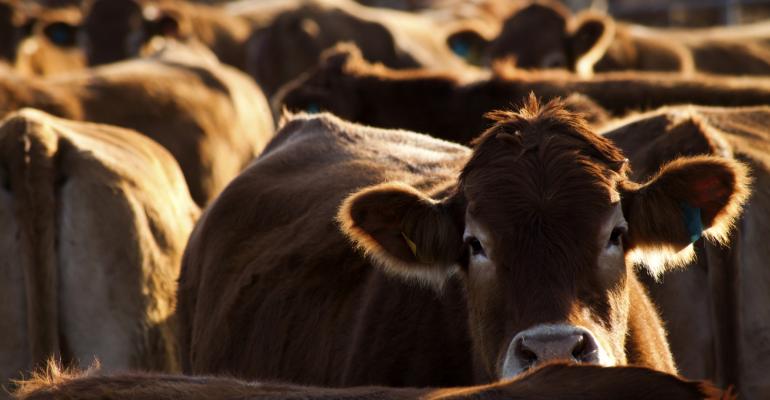What does Census say about cattle on feed operations and sales for slaughter?
Information on cattle on feed operations and sales for slaughter.
May 25, 2024

By Russ Euken, ISU extension livestock specialist, and Lee Schulz, ISU extension livestock economist for Iowa Beef Center
USDA’s National Agricultural Statistics Service released the 2022 Census of Agriculture full report on February 13, 2024. It contains a wealth of information. So much so that it can be somewhat difficult to sort through it all. Although there are more frequent reports on cattle inventories, the Census provides data on the number of operations by size of inventory and by sales per operation. It also provides information at the national, state, and county level and for different enterprise such as beef cows and cattle on feed. The Quick Stats database can be used to retrieve, in an Excel spreadsheet, customizable queries of Census data. Within Quick Stats, data is available for the last six Census years―1997, 2002, 2007, 2012, 2017, and 2022. Trends can be identified by looking across multiple years of data. This article provides information on cattle on feed operations and sales for slaughter. Data is summarized at the national, regional, and county level for Iowa for the last three Censuses. Next month’s article will look at beef cow operations and inventories in a similar fashion.
Cattle on feed numbers nationally
For cattle on feed for slaughter the national data shows 2022 sales of 24,449,077 head from 25,783 operations. The number of head sold was similar to 2017 but down roughly one million head from 2012. The number of operations has decreased by about 4,490 from 2017 and 8,097 from 2012. In 2022, 77.4% of cattle on feed sales for slaughter were from operations with sales of 5,000 head or more. Furthermore, 92.0% of sales were from operations with sales of 500 head or more. Those operation sizes account for 2.1% and 13.0%, respectively, of the cattle on feed operations in the United States. Operations with less than 200 head sold, account for just under three-quarter of all cattle on feed operations but only account for 4.1% of the cattle sold. From 2012 to 2022, the number of operations selling more than 500 head has Increased from 10.1% to 13% of all operations and the percentage of cattle they sold has increased 1.9%.
Kansas, Nebraska, and Texas are the leading states in cattle on feed sales for slaughter. Iowa and Colorado have jockeyed for 4th and 5th in the past 3 Census counts with Iowa taking 5th place in 2022 Census with sales of just over 1.8 million head. Iowa ranks first in number of operations with sales for slaughter with 4,102 followed by Wisconsin, Minnesota, and Nebraska. Iowa has 1,934 fewer operations than in 2012 and 1,383 fewer operations than in 2017. All states in the top ten nationally in number of cattle on feed operations have seen decreases in operation numbers from 2012 to 2022. All states in the top ten in sales, except Kansas, have seen decreases in sales over the last ten years.
Cattle on feed numbers in the north central United States
Twelve states make up the north central United States. These states include Illinois, Indiana, Iowa, Kansas, Michigan, Minnesota, Missouri, Nebraska, North Dakota, Ohio, South Dakota, and Wisconsin. In 2022, these states accounted for over three-quarters (75.9%) of the total U.S. cattle on feed operations and 59% of the total sales for slaughter.
For 2022 sales, Kansas and Nebraska lead the way with 5.4 and 5.0 million head sold, respectively, from 945 Kansas and 1,658 Nebraska operations. Iowa follows with 1.8 million head sold from 4,102 operations. In terms of number sold, Minnesota, South Dakota, Illinois, Wisconsin, Michigan, Missouri, Indiana, and North Dakota are next in that order. Wisconsin and Minnesota both have about 2,700 cattle of feed operations which is enough to put them directly behind the poll leader Iowa. Nebraska and Illinois are next with 1,658 and 1,548 operations, respectively. Indiana, Missouri, Michigan, South Dakota, and Kansas all have around 1,000 operations and North Dakota has 329 operations. The number of head sold per operation varies greatly between these states. For example, Kansas has 90 operations marketing just over 5.0 million head while Iowa has 4,102 operations marketing just over 1.8 million head. This equates to an average of 440 head sold per operation in Iowa. The average number sold per operation in Kansas is 5,694 head.
All the north central U.S. states had declines in cattle on feed operations over the 2012 to 2022 period. States with the least number of operations tended to have fewer operations exit. Indiana, Michigan, Minnesota, and Missouri had modest gains in sales of cattle on feed from 2012 to 2022. Kansas increased sales by over 550,000 head while Nebraska held relatively steady. The remaining states all saw a decrease in sales with Illinois and Iowa having the largest decreases.
County-level Iowa cattle on feed numbers
Cattle on feed operations are numerous in Iowa compared to many states that have larger sales for slaughter but fewer operations. Of course, this means, in comparison, Iowa cattle on feed operations tend to be smaller. In 2022, 62.9% of Iowa operations had less than 200 head of cattle sold per operation. The number of head sold from these operations accounted for 8.8% of the total sales. Iowa operations with 200 to 999 head in sales accounted for 26.6% of the total operations and 28.4% of the total head sold. Operations with over 1,000 head sold accounted for 10.5% of operations but had 62.7% of the total sales.
There is a large range in number of cattle on feed operations and sales for slaughter among individual Iowa counties. The top Iowa counties for cattle on feed operations are Sioux, Delaware, and Dubuque which all have about 200 operations. These Iowa counties are in the top six nationally, while the next three Winneshiek, Jackson, and Lyon have about 120 operations and are in the top ten nationally. There are 3,007 counties in the United States. Stearns county in Minnesota, Lancaster county in Pennsylvania, and Grant county in Wisconsin are the top three counties for cattle on feed operations with 299, 268, and 217 operations, respectively. The fewest number of cattle on feed operations in Iowa were in Fremont and Mills counties in southwest Iowa, Van Buren county in southeast Iowa, and Hamilton county in north central Iowa.
In sales for slaughter, Sioux county leads the state with 344,902 head sold. This ranks 13th nationally. Following Sioux county in Iowa are Lyon and Dubuque counties with 85,728 and 76,107 head sold, respectively. The next four counties in order are Delaware, Carroll, Plymouth, and Jackson ranging from 68,766 head to 47,446 head sold. Counties in Kansas, Texas, and Nebraska are in the top 5 nationally in sales for slaughter.
Cattle on feed operations in Iowa are concentrated in the northwest, northeast, and east central part of the state with a few counties in west central and southwest Iowa having larger numbers. The top five counties in sales for slaughter in Iowa sold 35.5% of the total in the state while the top ten sold 48.8% and the top 15 counties sold 58.4%. Counties in the northwest and west central area of the state have slightly larger operations than counties in the northeast area. There are larger cattle on feed operations scattered across the state, but most counties have predominantly smaller feedlots of less than 200 head in sales.
Iowa has seen a decline in the number of cattle on feed operations and sales for slaughter over the last 10 years. Most of this decrease has been in smaller operations with a drop of 1,017 operations with less than 100 head sold and a loss of 887 operations with 100 to 499 head sold. There was a 69 operation increase in operations over 1,000 head sold. The largest decrease in sales for slaughter was from operations in the 200 to 499 head sold category with a slight increase in sales from operations with over 1,000 head in sales.
The two graphs below show Iowa cattle on feed operations and sales for slaughter by size category according to the Census of Agriculture for 2012, 2017, and 2022.
See the data compiled from the 2022, 2017, and 2012 Agriculture Census data for cattle on feed for slaughter by size of operation on a national basis, for the north central states, and for Iowa counties.
See the June 2024 issue of Growing Beef for information based on cow-calf operations.

You May Also Like



